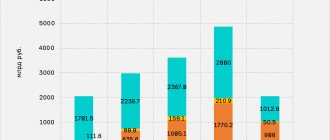The rapid ups and downs of the domestic financial market against the backdrop of increased restrictions on attracting foreign investment have exacerbated the eternal problem of generating investment resources for Russian entrepreneurs.
The growth of the financial and economic crisis has changed the views of managers and business owners on the process of attracting additional funds and their subsequent development.
A visible trend of the last five years is a progressive decrease in the number of financial organizations of various types.
The number of microfinance organizations and credit consumer cooperatives decreased by approximately 9 percent, the number of insurance organizations and brokers, pension funds decreased by more than 17 percent, and trust managers and dealers decreased by almost a third.
However, a truly powerful decline is observed in the segment of joint-stock investment funds, which are literally “melting” before our eyes. Over the past two years, their number has decreased by almost 34 percent.
The market for financial and credit services clearly sets priorities and subtly captures the preferences of consumers of investment resources, clearing the sector of outdated forms of investment financing.
To achieve significant results of financial and economic activity, it will be necessary to delve into a specialized conceptual apparatus and involve modern methods of their assessment in everyday practice.
Sources of formation
The formation of sources of financing occurs according to the type of ownership:
- Own. This is money, depreciation deductions, profit from current production, income from securities, etc.
- Borrowed. Loans from organizations and banks, bonds, investments, that is, any investments of individuals and legal entities attracted for a specified period with the payment of interest.
- Attracted. Targeted investments of commercial organizations, grants, investment contributions to the authorized capital, targeted subsidies from government agencies, that is, finances not encumbered by debt obligations.
Types of investment resources and their characteristics
[1]. Bringing data from multiple sources to a single denominator, we can propose a generalized classification of investment resources based on the sources of their receipt:
- on-farm reserves and own sources (all kinds of savings and savings, insurance payments, profit, income from main economic activities);
- borrowed funds , including bond and other loans, borrowings from extra-budgetary funds, credit resources, incoming payments under leasing agreements;
- resources attracted from third-party investors , including proceeds from the sale of shares.
Individuals and legal entities can act as investors, cooperation is confirmed by a concluded agreement. In the future, the organization will have to fulfill its obligations to the investor.
[2]. Depending on the form of ownership, resources isolated for investment purposes can be classified into: (1) private, (2) state, (3) foreign or (4) mixed.
The state often makes attracting foreign investors a priority, for which it creates and actively supports preferential government programs. Attracting funds from abroad has a positive effect on the country's economy.
Similar programs can be implemented to support small or medium-sized businesses, and therefore the relevant business entities have the right to count on replenishing their own funds through government subsidies and subsidies.
[3]. It is permissible to classify investments - according to the degree of risk - into (1) those that do not entail risks (risk-free), or (2) those that may cause loss of funds (risky).
[4]. Various forms of investment capital are used in the financial market. The most widely used are:
- money - placed in a current or other account, can be used to achieve various goals;
- property with a production purpose: machines, tools, machinery and other equipment;
- reserves, which are raw materials and consumables; they can be accumulated by the organization to ensure uninterrupted operations, and, if necessary, can be sold to obtain funds and invest them further;
- the organization's personnel can also be considered as an investment in case of high qualifications; training and retraining of specialists requires significant time and financial expenditures;
- intellectual assets (for example, a license to use certain technologies).
Forming factors
When forming resources, you need to take into account the following factors:
- Production characteristics of the enterprise. Allows you to determine the structure of assets and their liquidity. Example: a narrow-profile production of equipment for the mining industry (capital-intensive with low liquidity) or a cosmetics company (fast asset turnover and high liquidity).
- Production size. The smaller the enterprise, the higher its need for investment.
- Cost of borrowed capital. The loan rate depends on the solvency of the enterprise, the form of collateral, credit rating, type of audit report, etc.
- Independence in choosing investment sources. A large enterprise with liquid assets can finance the project independently.
- Income tax rate. This is an external factor that depends on the tax policy of the state.
- Risk level. This factor is directly related to the investment strategy. An aggressive strategy with a short investment period and higher income increases the degree of risk. A conservative strategy reduces possible risks, but reduces the profitability of the project.
The concept of enterprise investment resources
Any types of financial assets used for subsequent investments are usually called investment resources .
The more diverse the resources and the greater their volume, the wider the enterprise’s ability to successfully implement its investment policy.
Resource consumption largely depends on their quality and availability. They are used as a material base in the process of creating and establishing a new company.
An enterprise in its production activities can “rely” on a wide range of resources, a significant part of which must be spent on investments. At the same time, they are classified according to a wide range of different criteria.
Demand forecast
A demand forecast is developed in order to effectively use and wisely distribute finances between investment objects.
Modeling is divided into several stages:
- Analysis of quantitative and qualitative directions of the project.
- Forecasting possible problems: with the investment of funds by sources of financing and in the distribution of reserves among objects.
- Time forecasts (short-term, medium-term, long-term). Forecasts are needed for planned financing; they necessarily take into account impact factors.
Principles of attraction
In conditions of a high level of competition, the issue of rapid growth and development of one’s own activities becomes acute. It is rapid growth and the possession of a significant market share that gives maximum economic results today.
It is this need that gives rise to the need for business owners to attract capital. Own resources are not always able to cover the volume of investments necessary for further development.
Attracting investment resources is the key to competitiveness.
It is clear that every investor needs the security of his capital and good dividends from participation in the project.
List of factors that can positively influence attracting investment in business:
- state support and benefits, creation of joint projects
- modern tax legislation
- transparent legislative framework
- state guarantees and protection of investor rights
- implementation of concession projects
- availability and transparency of information about the current financial condition of the enterprise
- clarity and consistency of company development
- improving the structure of investments aimed at updating and acquiring fixed assets
- reduction of the investment cycle
- full coverage and demonstration of investment opportunities for investors, creation of an information business map
- benefits in land use, as well as in the use of other natural resources
- preferential lending
- possibility of privatization.
Find places where investors gather
Unfortunately, posting an ad “Looking for an investor” is not the smartest option, but finding a business partner may not be as difficult as it seems at first glance. It will be enough to know a few places where owners of large companies and investors who are ready to invest in a profitable business gather. As a rule, such gatherings take place at various gala evenings, which are quite difficult to get an invitation to, but the game is worth the candle spent on it - you can rest assured of that!
Today, various events at which competitions are held among entrepreneurs are very common. As a rule, the winners of such competitions receive support from wealthy people and the right to long-term cooperation. If you don't find what you're looking for at the banquet, you can at least gain experience by interacting with major financiers and corporate owners. The format of such parties allows young businessmen to show themselves and their products to big businessmen.
Main types of cash flows of an organization
Types of cash flows of an organization by direction of movement:
- Positive cash flow (PDF) or cash inflow is the amount that flows into the organization’s account from all types of transactions.
- Negative cash flow or cash outflow is the amount of payments for all types of transactions.
- A single comprehensive object of financial management – RAP and EDP. These two types of cash flows of an organization are closely interrelated. A reduction in one type of financial flow over a certain period of time leads to disruption of synchronization and a reduction in the flow of the second type.
Types of cash flows of an organization by management levels
(financial responsibility centers, projects, activities):
- DP for financial services of the enterprise as a whole.
- DP for financial services of individual structural divisions and central financial districts (financial responsibility centers) of the company.
- DP for individual financial transactions that are subject to independent management.
Effective financial management allows you to analyze and timely assess the most vulnerable areas of fund management in order to immediately plan and take appropriate anti-crisis measures.
Types of cash flows of the organization by type of activity:
- DP for current activities. It includes income from all completed sales, advances received from customers, payments from auxiliary operations, settlements with suppliers, payroll, and tax deductions.
- DP on investment activities. This includes all types of financial transactions related to the purchase of property and the sale of long-term assets.
- DP on financial activities. Combines various credit receipts, loans, repayment of interest on loans, payment of dividends on securities (shares, bills).
Types of cash flows of an organization in relation to the company:
- Internal (IDP) – movement of money within the enterprise.
- External (VDP) – the movement of financial resources between an enterprise and its counterparties (suppliers, customers).
Types of cash flows of an organization by calculation method:
- Cumulative (ADP) – the entire amount of receipts or payments of funds for a period of time at intervals.
- Net (NPP) – the difference between positive (PDP) and negative (NPD) flows for a period of time by intervals.
Net DP is of great importance for determining the market value and financial position of the enterprise; it determines the performance of the company.
NPV can be calculated for the enterprise as a whole and for individual financial responsibility centers (FRC). The calculation is performed using the formula:
Amount of NDP for the period = Amount of DDP (funds received) for the period – Amount of DDP (funds paid) for the period.
The amount of NPV affects the size of the company's financial assets. The NPV indicator can be either positive or negative.
Types of cash flows of an organization by level of balance:
- Balanced (SDP) can be calculated for the enterprise as a whole, for a separate center of financial responsibility, for a specific operation.
The balance between individual types of cash flows of an organization for a period is calculated using the following formula:
Amount of DDP = Amount of DDP + Provided increase in the amount of cash reserves.
- Unbalanced (NDP) is a deficit or surplus (excess) total financial flow. In case of insufficient funds or excess of income over expenses, the balance is not ensured.
Types of cash flows of an organization by time period:
- Short-term (KDP) - the calculation is made for a certain period, from the beginning of receipt of payments to the end, but not more than 1 year.
- Long-term (LTD) - calculated over a period of more than 1 year, from the beginning of receipt of payments until the end of a certain period.
Short-term DP refers to the current and partly to the financing activities, and long-term DP refers to the investment and partly to the financing activities of the company. For example, these could be long-term loans or loans. Calculations of KDP and DDP are used for individual operations of the enterprise.
Types of cash flows of an organization by importance in the formation of financial results:
- Priority (PDP) is a high level of NPV or net profit of the enterprise, for example, from the sale of goods.
- Secondary (VDP) - has an insignificant volume, therefore it does not significantly affect the financial results of the company (for example, the issuance of accountable funds).
Types of cash flows of an organization using the time estimation method:
- Current (TDP) – the indicator is compared with the value at the current time.
- Future (FDP) - the indicator is compared with the cost at a certain future point in time.
Most often, classification according to the time estimation method is used when determining the future profit of an enterprise - discounting.
In accordance with international financial accounting standards, an organization's cash flows are divided by type of economic activity:
- DP for operating activities - payments to suppliers of raw materials, deductions for the services of third-party contractors.
- DP for investment activities - payments and receipts when investing.
- DP for financial activities - payments and receipts related to attracting equity or other funds, obtaining long-term or short-term loans and borrowings.
The above classification is necessary for accounting, effective planning and analysis of the continuous cash flow of the enterprise. Competent financial management is based on a standard financial accounting system.
Perhaps the state or bank will help?
You may be interested in: Fee for servicing a Sberbank bank card: terms of use, types of cards and tariffs
Some entrepreneurs flatly refuse the opportunity to take out a loan from a bank to develop an enterprise, although such actions can often be very profitable. The only problem may lie in the preparation of various documents. Professional businessmen advise setting up an individual business or becoming part of a limited liability company for those people who plan to receive financing from a bank, since financial institutions are particularly willing to issue loans to such structures.
Also, a significant part of entrepreneurs do not even suspect that they have the right to receive financing from the state. In this case, trying to attract the attention of certain structures will be extremely unwise - you yourself need to be interested in how to get a subsidy or cash grant. For example, in the Krasnodar Territory, subsidies are given for the construction of greenhouse complexes, since the region needs fresh vegetables and berries. Anyone who wants to build a greenhouse on their property can receive financing.
Hire an experienced businessman to help you
Quite often, beginning entrepreneurs make very stupid mistakes, especially when concluding agreements with investors. If you do not want to embarrass yourself by not knowing the basic concepts of housekeeping, then we strongly recommend hiring an experienced partner to help you, who will solve complex problems for you and advise if necessary. If an investor sees that your team includes competent specialists, then he will subconsciously think that you are several times more experienced than them. As a result of this, you and your company will become a win-win option for investors, where they can safely invest all their savings.











